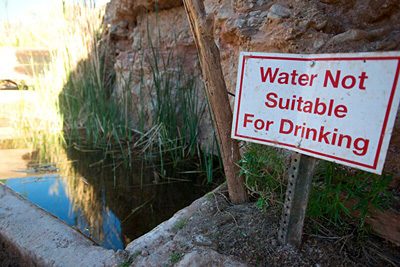Conservationists Back Havasupai Tribe’s Opposition to Grand Canyon Uranium Mine
Arizona Regulators OK’d Mine Permit Despite Risk to Canyon’s Water

All Global Research articles can be read in 51 languages by activating the “Translate Website” drop down menu on the top banner of our home page (Desktop version).
To receive Global Research’s Daily Newsletter (selected articles), click here.
Visit and follow us on Instagram, Twitter and Facebook. Feel free to repost and share widely Global Research articles.
***
Conservation groups joined the Havasupai Tribe today to denounce the Arizona Department of Environmental Quality’s approval of a key permit for a uranium mine near Grand Canyon’s South Rim. On Friday the Tribe sent a letter to Arizona officials reasserting its opposition to the mine and calling for new hydrological studies, regular meetings and monitoring data for the Pinyon Plain Mine.
“Our identity as a people is intrinsically intertwined with the health of Havasu Creek and the environment to which it gives life. We use this water for drinking, gardening and irrigating, municipal uses, and cultural and religious uses,” the Tribe’s letter said. “If the water source becomes contaminated like we have seen in other areas of Arizona due to uranium mining, we will no longer be able to live in our homes and Supai Village will become extinct.”
The mine, owned by Energy Fuels Resources, has a history of flooding as it drains shallow groundwater aquifers that flow into South Rim springs. The mine also threatens to contaminate deep aquifers that feed Havasu Creek and other Grand Canyon springs.
“State regulators are bowing to the uranium industry while risking irretrievable harm to groundwater feeding Havasu and other Grand Canyon springs,” said Taylor McKinnon at the Center for Biological Diversity. “Charging forward amidst dangerous scientific uncertainty threatens human rights and makes the Grand Canyon state the Grand Canyon’s worst enemy. Mine remediation and closure remains the only safe option.”
In April the state issued an aquifer protection permit for the mine, located in the Red Butte traditional cultural property on the Kaibab National Forest. For years the Tribe and conservation groups have urged the state to close the mine.
“Sierra Club continues to vociferously oppose this uranium mine as we have for several decades and will work with the Havasupai Tribe and our partners to do everything possible to keep it from harming the waters of Grand Canyon and Havasu Creek,” said Sandy Bahr, director of Sierra Club’s Grand Canyon Chapter. “Pinyon Plain Mine and this permit demonstrate that our state and federal laws need to be stronger to protect our waters and critically important cultural areas from harmful uranium mining. It is why we need mining law reform, the Grand Canyon Protection Act, and stronger state water protection policies.”
The agency’s permit downplays research from the U.S. Geological Survey showing “a hydrologic connection in the area of Canyon Mine” between the Coconino aquifer, which is flooding into the mine, and the deeper Redwall-Muav aquifer, which is the source of the largest springs in the Grand Canyon and Havasu Springs on the Havasupai Tribe’s land.
It also sidesteps federal research that “contaminants, either from land-surface or subsurface sources, are likely to be transported into the deep aquifer.”
“The Pinyon Plain Mine threatens groundwater and defaces an area of profound cultural significance to the Havasupai Tribe,” said Amber Reimondo, energy director for the Grand Canyon Trust. “By approving this permit, the state is gambling, but the Grand Canyon region’s water is too precious to risk. Uranium mining should be permanently banned near the Grand Canyon.”
In 2016 mineshaft drilling pierced shallow aquifers, causing water pumped from the mine to spike from 151,000 gallons in 2015 to 1.4 million gallons in 2016. In the years since then, inflow has ranged from 8.8 million gallons in 2017 to 10.76 million gallons in 2019; most recently, the mine took on 8,261,406 gallons of groundwater in 2021. Since 2016, dissolved uranium in that water has consistently exceeded federal drinking water toxicity limits by more than 300% and arsenic levels by more than 2,800%.
“Mining uranium in the Grand Canyon watershed threatens the landscape and jeopardizes the water supply of the Havasupai people,” said Michè Lozano, Arizona program manager for the National Parks Conservation Association. “The Pinyon mine should be closed and uranium mining near the Grand Canyon permanently banned. Passing the Grand Canyon Protection Act will provide lasting protection for the sacred sites and critical waterways in this region.”
As early as 1986 some state officials warned that mining could pierce and drain shallow aquifers into the mine and contaminate the regional groundwater that feeds seeps and springs in the Grand Canyon. Other hydrologists have since echoed that warning, pointing to more recent science suggesting that uranium mines could contaminate and deplete aquifers connected to Grand Canyon springs.
“In the face of millions of gallons of groundwater now pumping out of the Pinyon Plain mineshaft each year, the state still finds ‘no evidence’ of risk to aquifers from this uranium mine, and makes a glaring oxymoron of the aquifer protection permit,” said Wild Arizona’s Executive Director Kelly Burke. “The Havasupai people and Grand Canyon deserve far greater professionalism, and stronger, more enduring protections like the Grand Canyon Protection Act, to defend the Canyon’s life-giving waters.”
*
Note to readers: Please click the share buttons above or below. Follow us on Instagram, Twitter and Facebook. Feel free to repost and share widely Global Research articles.
Featured image: A spring near Grand Canyon contaminated by nearby uranium mining. Photo Kristen M. Caldon 2015, www.kmcaldon.com.

